|
1.
CENTRAL/ WEST AFRICA
Sawn timber business slow in West Africa
Demand from Asian buyers has been good enough to keep
the remaining active log exporters reasonably busy and
prices stable over the past weeks. Congo Brazzaville
resumed limited volume log exports about two months ago
and after a slow start a few exporters have now actively reentered
the market.
Buying for Europe has not strengthened although there
have been some sales in relatively small volume for
Portugal. French importers are well stocked but have
recently made a few contracts for species where their
inventory is low. The low demand for Continental Europe
will not improve during the traditional summer vacation
period that is now in full swing and traders are not
convinced that business will show much if any
improvement until the fourth quarter. The construction
industry has been hit very hard in the recession and the
number of jobs lost in this sector is larger than any except
banking and finance. Log exporters expect to rely on
Asian buyers for stability through the third quarter of the
year and shipments to China being the largest in volume.
Sawn lumber business is very slow, with Europe still very
much out of the market. Although reports indicate stocks
are running low in the UK, extremely limited demand for
tropical hardwoods keep buyers unwilling to speculate on
new purchases. Enquiries for FSC or other certified
lumber has shown some improvement but producers say
price competition is such that they do not recover the extra
costs for certified products.
Producers in Africa show no signs of gearing up for higher
volume output in logs or sawn lumber and some are
rumored to be considering a reduction in output.
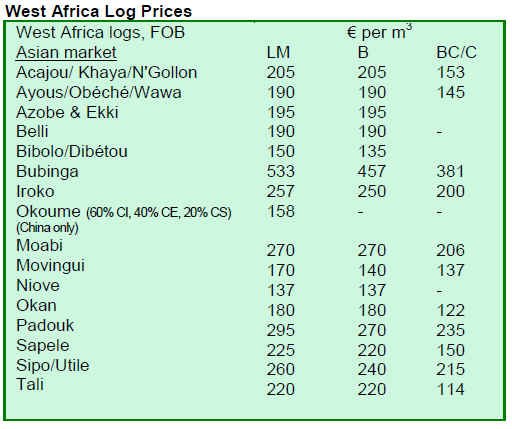
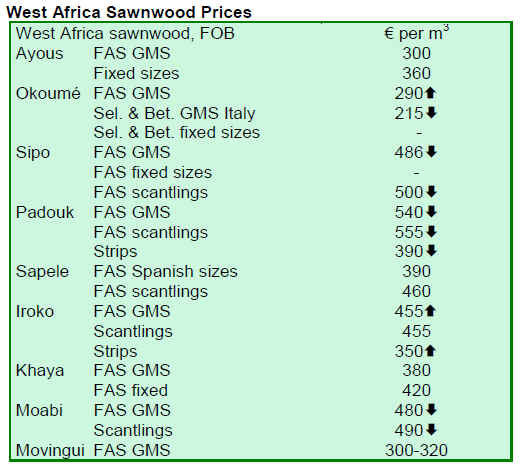
2. GHANA
Teak planting project to benefit Ashanti region
Dr. Owusu Afriyie Akoto, Member of Parliament for
Kwadaso, has initiated a teak-planting project for schools
in his constituency in the Ashanti region in Ghana. The
project was intended to provide some 40 schools in the
area with 15,000 teak seedlings for planting on school
compounds. The aim was to raise awareness of school
children to the value of trees. Under the project, each
school child is to be given a number of teak seedlings for
planting, watering, weed control and pruning as part of
school daily curriculum and from all indications interest in
the project is growing.
At the launch, Dr. Akoto said the vision behind the project
included environmental, economic and social aspects and
was designed to train students to appreciate the role of
trees in environmental restoration and raise resources to
finance schools* future expansion of educational facilities.
To ensure the success of the project, the MP will present
an award to schools that excel in the initiative. Mrs Edith
Abroquah, the Ashanti Regional Minister of the Forestry
Services Division (FSD), who represented the Minister of
Lands and Natural Resources, commended the MP for his
initiative, said she hoped the initiative would prove a
success and offered FSD*s support to ensure its success.
First quarter contract volume drops
Ghana*s timber trade saw a further decrease in the volume
of wood products processed and approved by the Timber
Industry Development Division (TIDD) during the quarter
under review. A total contract volume of 107,184 m³ and
1,801 pieces of furniture parts representing decreases of
29.60% and 81.06%, respectively, were processed and
approved as compared to the figures achieved during the
last quarter of 2008. Demand for wood products has
reduced considerably in the major importing countries of
Germany, Italy, Spain, the UK and the US since the onset
of the global financial crisis.
With the exception of teak poles/billets/logs, which mainly
go to the Indian market, all the major exportable products
experienced further decreases in volume during the quarter
under review. Compared with figures from fourth quarter
2008, teak poles/billets/logs increased by 111.75% to
reach a volume of 29,078 m³, while lumber, plywood,
sliced veneer, rotary veneer and finger jointed products
decreased in volume, ranging from 9% to 22%. The TIDD
contract office in Kumasi, Accra and Sunyani processed
and approved 36.91%, 5.99% and 6.93%, respectively, of
the total volume of wood products during the quarter
under review, with the headquarters in Takoradi
contributing the remaining 50.17%.
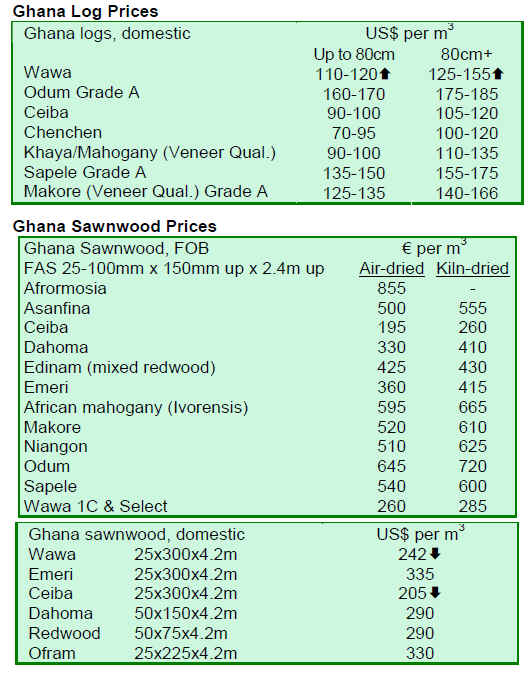
3.
MALAYSIA
Minister encourages stopping log and sawnwood exports
Chief Minister Datuk Seri Musa Aman has encouraged the
East Malaysian state of Sabah to stop exports of logs and
sawnwood in the near future in order to generate more
employment and investment in the downstream processing
sector. According to The Star, Musa further noted that
sustainable forest management would be practiced in
natural forests and that tree plantations would be
established in degraded and heavily logged areas.
In line with this transition, the Minister helped launch a
Sino-Malaysian RM230 million joint-venture to create
12,000 hectares of rubber plantation in Sabah, reported the
Daily Express. The project is located in the Bornion
Timber concession area (Forest Management Unit 11) in
Ulu Sungai Milian. The Bornion Guangken Rubber Forest
Plantation project is a joint venture between Bornion
Timber and Guangdong Guangken Rubber Group Co. Ltd.
of Guangdong Agribusiness Group Corporation of China
and is expected to be completed in six to eight years* time.
When completed, it will be one of the largest rubber
plantations in Malaysia. To date, Bornion Timber has
planted 3,500 hectares out of the 25,000 hectares allocated
for rubber planting. It has also planted 800 hectares of
acacia under the Industrial Tree Planting (ITP)
programme.
Similar initiatives have been seen in the state of Sarawak
with 5,000 hectares of rubber trees expected to be planted
by government agencies under the Ninth Malaysia Plan.
The Star reports that 1.9 million hectares of available land
in East Malaysia has been identified as suitable for rubber
trees cultivation, out of a total of 41.2 million hectares of
commercial agriculture land. The Sabah regional office
director of the Malaysia Rubber Board, Dariman Darham,
estimated that about 1.5 million hectares of land was
available for rubber tree cultivation in Sarawak while
400,000 hectares was available in Sabah.
Malaysia keeps close watch on China*s skyrocketing shipping rates
Malaysian timber products manufacturers are keeping a
close watch on their competitors in China as the second
largest container carrier in China - China Shipping
Container Lines Co. - increased its rates for Asia-Europe
routes by almost 100% from 1 July 2009 onwards. Rates
for Asia to Europe routes would rise to as much as
USD650 per 20 foot container, said China Shipping
Container Lines Co*s managing director Huang Xiaowen
to the Business Times.
Shipping rates usually increase from July 1 every year as it
is the busiest season for sea-cargo box carriers. The new
rates may make Malaysian timber products more
competitive if other shipping lines in China take similar
actions and Malaysian shippers hike their current rates
only marginally.
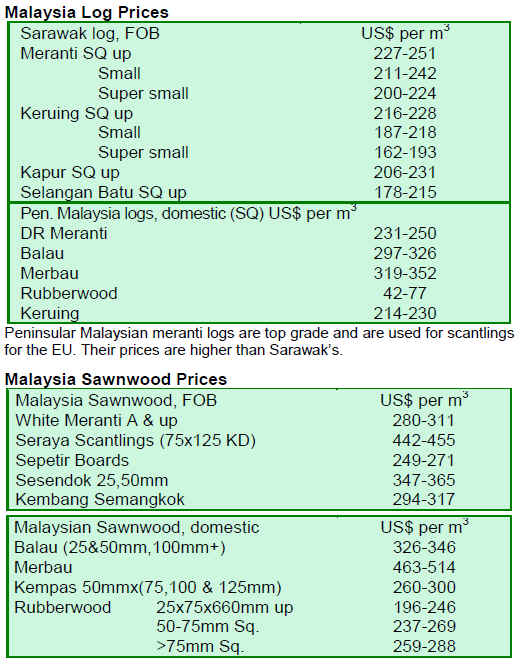
4.
INDONESIA
Forestry Minister requires independent certification of
timber exports
Indonesian Forestry Minister Mr. MS Kaban announced
that all timber products leaving the country must be
independently certified by an independent body consisting
of representatives from both the timber business sector and
NGOs. The Jakarta Globe reported that the new directive
is designed to stop the flow of illegally traded products.
NGO representatives expressed support for the measures,
noting they would help boost the image of the
government*s monitoring and oversight capabilities by
involving new stakeholders in the certification process.
SME sector could grow despite overall economic gloom
The Deputy Chairman of the Indonesian Chamber of
Commerce and Industry, Mr. Sandiaga Uno, commented
that the Small and Medium Enterprise (SME) sector is
poised for higher growth. He said SMEs in Indonesia
contribute up to 50% of national economic growth,
reported Tempo Interactive. Most of Indonesian timber
products producers are SMEs, in particular furniture
manufacturers, which are often community-based or
operated by family owned businesses. According to Mr.
Uno, SMEs in Indonesia could contribute to growth of up
to 25% if given adequate government support such as
further capital and training on finance, management and
marketing techniques.
Business pauses as elections conclude
Most trading activities in Indonesian have come to almost
a standstill as the country held its national general
elections on 8 July 2009. Businesses are looking forward
to more positive changes in both state and federal laws and
regulations that will encourage more foreign direct
investments, as well as technology transfer to hire
currently unemployed skilled workers and university
graduates.
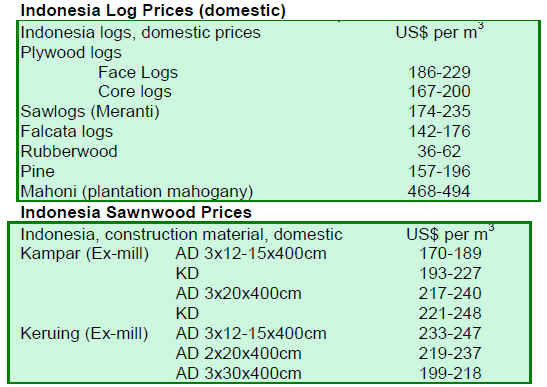
5.
MYANMAR
Teak exports drop from Myanmar
Local experts indicate Myanmar*s market situation is quite
erratic at present, especially for teak exports. First quarter
comparisons for FY2008 and 2009 show slides in export
figures: teak log shipments fell about 60%; hardwood log
shipments dropped about 6%; and sawn teak (primarily
processed) shipments slid nearly 57%.
A year-on-year comparison of tender prices showed mixed
results. Average prices of fourth quality and sawing grades
1, 2 and 3 of teak fell up to 16% in June 2009 when
compared to 2008 prices. Average prices for the lower
sawing grades (5, 6 and 7) rose to a maximum of 80% in
June 2009.
Prices drops of the higher grades occurred due to a slide in
demand, particularly due to declines in European
purchasing of these grades during the period specified.
Prices for the lower grades that go to Asian markets rose
because of short supply and other factors such as
purchasing on an FOB basis and better quality of log
producing areas. The table below shows a year-on-year
price comparison for teak:
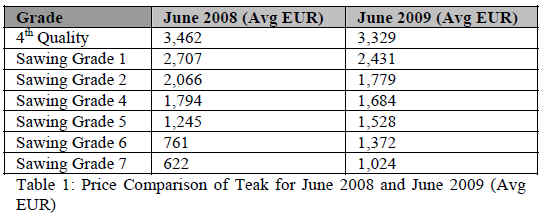

6. INDIA
Export figures for timber products show gains by value
Indian economy grew by 6.7% during the first half of 2009
as against an average growth of 8.8% in the previous five
years. The slowdown in 2009 was primarily due to the
global financial meltdown and consequent economic
recession in developed economies. The growth outlook for
FY 2010 is maintained by the government at 7% and since
the present government has full majority in the parliament
it is hoped that many of the measures outlined by the
government will be implemented. The foreign trade
figures for May 2009 were in line with the expectations.
Despite depressed export and import figures in other
countries, wood and wood products have remained unaffected.
While there has been a general shrinkage in
exports, the decline in imports is greater, thereby reducing
the trade deficit for the first two months of 2009 to
USD10.2 billion compared to USD19.88 billion in the first
two months of 2008, mainly because of lower rates for
crude in the current market.
The figures for exports of wood products for the financial
year 2008-2009 were set at a target value of 22,635
million Rupees, with the actual exports estimated to be
worth 22,000 million Rupees during this period. Exports
during 2007-2008 were 1.9620 million Rupees. Exported
products were as follows (in million Rupees):
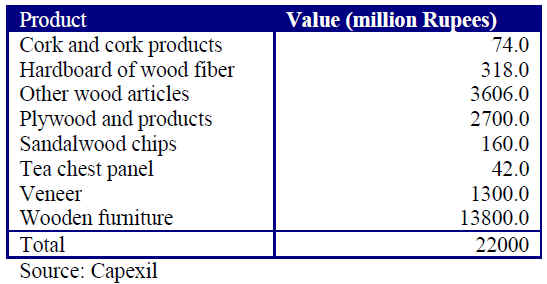
Exports of wood products would have been much better if
USA and EU demand did not plummet as an effect of the
global financial crisis. Buying from these countries has
been low, particularly for musical instrument components
made of Indian Rosewood (Dalbergia latifolia). Before
the ban on exports of Rosewood logs and sawn timber
exports, India used to export approximately 35,000 m³ to
Japan, Italy, Germany and other countries that used to
import them to manufacture veneers for fancy plywood
and musical instruments such as guitars. After the ban,
exports of parts such as sides and backs plus finger boards
for guitars jumped but presently, exports have been much
lower due to the global financial crisis.
Similarly, exports of all logs and sawn timber of Indian
origin are banned under the green cover programme. Only
sawn timber made of imported logs are permitted for
exports under this well monitored scheme. The main
conditions set by the programme indicate that against 100
m³ of timber imported, not more than 60 m³ will be
allowed for re-export and that the extent of value-added
activities of these products in the country must be at least
30%. Under this scheme, mainly teak sawn timber is
exported.
Door and window frames have continued to be a popular
product to Middle Eastern countries and flooring decking.
Prices for Middle East quality for door and window frames
were around USD2,200 /m³. Planks have been popular to
Australia, Europe and North America. Plank (6* to 6**)
prices to Europe have been up around USD5,000. Kerala
teak had been widely used by boat builders in the Persian
Gulf but having been banned, shipbuilding activity is now
done on India*s western coast ports and the ships export
mostly to the Gulf countries.
Auctions of teak and other hardwoods have also shown a
firm price trend. Currently, prices realized in ex-forest
depots of the Kerala government auctions are the
following:

Changes in Teaknet spur new initiatives
An informal meeting was held at Kerala Forest Research
Institute (KFRI), in Peechi, Kerala to discuss future
activities and areas where Teaknet could advise teak
planters, traders and consumers. The meeting was chaired
by Dr.K.V.Sankaran, Director of KFRI and consisted of a
variety of participants and other experts and researchers on
teak.
Mr. R.T. Somaiya, President of Timber Importers
Association of India and member of Teaknet Steering
Committee, provided the audience an overview of the
international teak trade. He emphasized the need to
standardize specifications, measurement systems and a
formula for arriving at the volume of bark and sap as they
differ in supplying countries. He said there is a need to
help teak planters improve the quality of growing stock,
pest control and the integration of plantations with natural
flora and fauna. Teaknet can also guide planters on the
most suitable habitats, and desirability of setting up
plantations where silvicultural practices such as weeding,
pruning, occasional ploughing and pest management can
be carried out economically, with the hope that these
activities will bring excellent returns at the time of harvest
and provide a quality as close to forest grown teak as
possible.
A seminar has been planned from 23-25 November 2009
at Peechi to discuss matters of interest to traders and
planters and Teaknet will be making an announcement of
this event officially shortly.
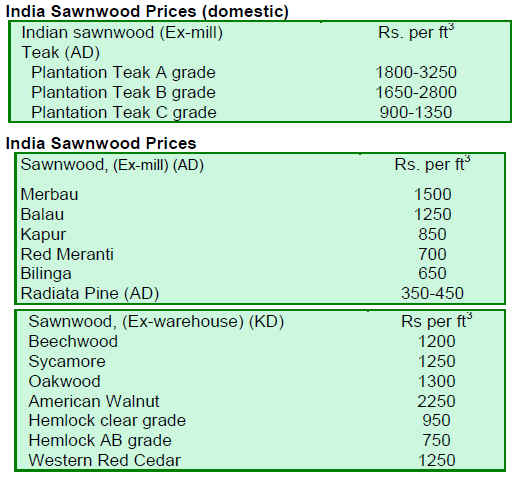
7. BRAZIL
Illegal timber seized in Marcelândia region
In an operation to combat illegal logging in the
municipality of Marcelândia, located in Mato Grosso state
in the Amazon region, the Brazilian Institute of
Environment and Renewable Natural Resources (IBAMA)
inspectors seized illegal timber and found that illegal
logging in the Amazon forest is continuing at a very fast
pace. In three months, timber equivalent to six thousand
trees has been seized in the region, reported Globo/S車
Not赤cias. Illegally logged timber is supplied to regional
sawmills, some of which operate illegally without permits
from environmental agencies.
In another municipality, also in Mato Grosso state (Ju赤na),
the Federal Police arrested 16 people during the &Arco do
Fogo* Operation, also designed to combat illegal logging.
Two check points were established in the municipality to
control timber trucks; a total of 14 trucks were seized with
approximately 2,500 m³ of timber, with an estimated value
of BRL200 thousand.
According to the inspectors of the region, illegal timber
transport is part of organized crime, as state and interstate
organizations are benefiting from the illegal logging
operations in Mato Grosso and throughout the Amazon
region.
NASA images reveal a drop in Amazon burning in 2008
New NASA research showed a sharp decline in the
quantity of smoke over the Amazon region during the
2008 burning season, coinciding with a drop of the
deforestation rate reported at the end of June 2009. The
burning in the region is primarily used to establish pasture
for cattle ranching, which is the main activity responsible
for land-use change in the Amazon.
According to Amigos da Terra, deforestation in the
Brazilian Amazon is increasingly caused by industrial
development rather than subsistence activities, considering
that the region is one of the world's major sources of meat
and soybeans. However, due to the global financial crisis,
the bank credit lines have not been easily opened and
commodity prices dropped, which discouraged forest land
conversion to pasture and other uses, leaving an area of
approximately 25,000 square kilometers degraded, but not
deforested. Forest burning dropped drastically in the 2008
burning season, leaving deforestation for the 2008-2009
year at its lowest level, below 10,000 square kilometers,
according to the Ministry of Environment (MMA).
The Brazilian government expects the trend to continue,
despite a recent drop in commodity prices. The Brazilian
government also agreed to reduce annual forest loss by
70% by 2018 under its national action plan on climate
change. Brazil expects industrialized countries to
contribute to its fund to protect the Amazon, which is
expected to avoid emissions of 4.8 billion tons of carbon
dioxide in the atmosphere.
Rio Grande do Sul*s furniture exports drop
The furniture industry of the state of Rio Grande do Sul (a
major furniture exporting state in Brazil) faced a 32.9%
drop in its exports between January and May 2009
compared to the same period of 2008. Some companies of
the state increased their exports to new or underdeveloped
markets such as Cuba, Uruguay and Angola (a 105.1%,
82.8%, and 13.2% increase, respectively). Comparing May
to April 2009, there was a 6.3% increase in furniture
exports of the state, amounting to USD15.2 million,
although furniture exports dropped 39% in May 2009
when compared to May 2008. The main reasons for the
decline were the high dollar exchange rate and barriers
imposed on imports by Argentina, one of the main buyers
of Rio Grande do Sul*s products.
According to Gazeta RS, the export figures for Brazil were
similar to those of Rio Grande do Sul state over the
January to May 2009 period, with a 32.1% drop in the
exports from the furniture sector, totaling USD260.8
million. The country that most increased its imports of
Brazilian furniture was Cuba. Although it represents only
3% of total Brazilian exports, it increased its imports by
85.5%. The US continues to be the main buyer of
Brazilian furniture, representing 15% of Brazil*s total
market share of exports were worth USD38.2 million, a
49.1% decrease.
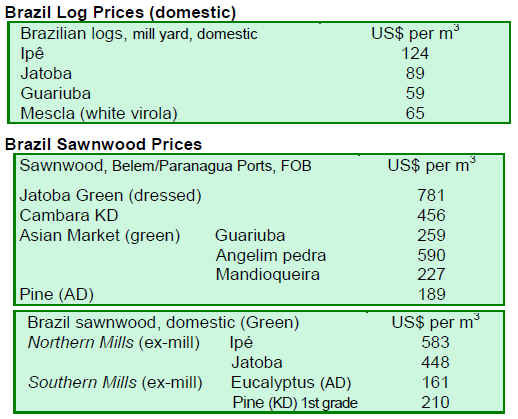
8.
PERU
Peru*s timber exports plummet 47%
According to recent statistics given by the Export
Association of Peru (ADEX), Peru*s timber exports from
January 每 March 2009 were USD54.61 million while for
the same quarter 2008 they were USD102.97 million, a
year-on-year decline of 47% (Chart 1). During the same
period, the three main timber export markets were China,
Mexico and the US, which overall represented 78.54% of
the wood sector exports.
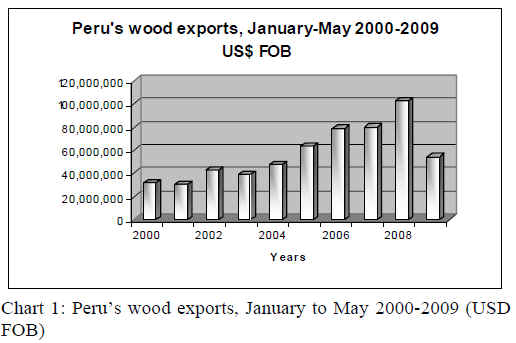
During the January 每 May 2009 period, New Zealand
imports of Peru*s timber products grew 262% against the
same quarter a year earlier. The primary imports consisted
of railway ties. This growth is similar to that of Panama,
which imported 104% more of Peru*s timber products
during the same period, primarily as a result of sawnwood
imports. China*s imports jumped 52.245%, with the Hong
Kong market showing a massive 476% gain in imports of
Peru*s timber products, particularly decking. On the other
hand, Mexican imports slumped 72.44% over the period,
as demand stopped for Peru*s mouldings.
Sawnwood, the second largest product exported during the
period, consisted of about 34% of timber exports. Exports
of sawnwood for the January 每 May 2009 period were
USD18.65 million by value while for the same quarter in
2008 the sawnwood exports were just over USD49
million, a year-on-year drop of 62.54%. The main market
of exports destination for this product was Mexico. A
year-by-year comparison for Peru*s sawnwood exports is
shown below:
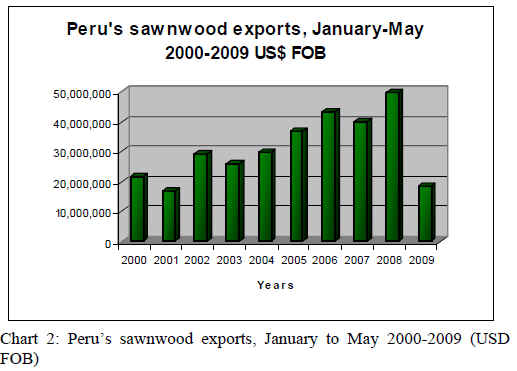
Semi-manufactured exports over the January 每 May 2009
period represented the largest product exported, consisting
of 41.5% of total timber exports (Chart 3). Exports were
worth USD22.66 million during the period, falling 20.91%
from the same period during 2008. The main destination
market in these products was China.

Exports of veneer and plywood for the January 每 May
2009 were USD5.52 million, dropping from USD 12.77
million for the same period in 2008. The Mexican market
was the main destination for Peru*s veneer and plywood
products. The chart below shows a yearly comparison of
Peru*s veneer and plywood exports by value.
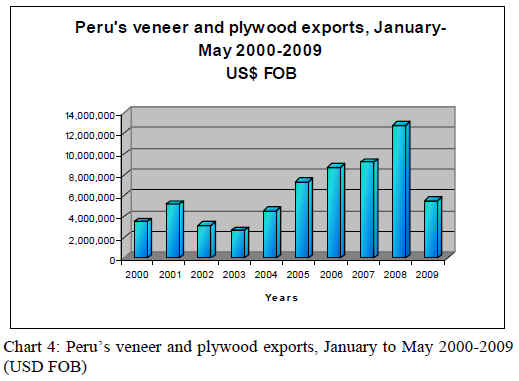
Exports of furniture and parts during the January 每 May
2009 period were USD3.21 million by value, nearly half
of what they were in the same quarter of 2008. The main
destination market for these exports was the US, which
received just over half of these products although its
import levels significantly declined during the same period
as a result of the global economic slowdown.
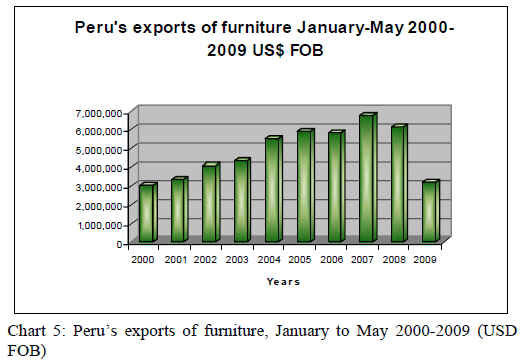

9. BOLIVIA

10. MEXICO
Mexico*s southeast region is host to most plantation
species
The main plantation areas in Mexico are located in the
southeast of the country, particularly Veracruz, Tabasco,
Michoacan, Campeche, Oaxaca and Guerrero. The species
planted in these areas include eucalyptus, melina, teak,
cedar and rubber wood. The two most important plantation
projects cover a total area of about 22,600 hectares. The
raw material from these plantations is sawnwood, pulp,
and rubberwood.
The main species planted in all areas of Mexico for
commercial purposes are: eucalyptus (15.85%), cedar
(12.02%), melina (7.71%), pine (7.37%), mahogany
(6.31%), teak (6.22%) and others. The table below shows
the places where these species are located in Mexico.

11.
Guyana
Prices for greenheart remain stable
Log prices for greenheart have remained relatively stable
over the last fortnight while prices for purpleheart
continue to increase on average by 20% for both standard
and fair sawmill quality. There has been a slight increase
in the export of mora logs with prices ranging from
USD90 to USD110. Prices for undressed sawnwood have
been fairly stable, while prices for dressed sawnwood have
comparatively increased during the same period. Plywood
prices continue to climb from the last fortnight in the
BB/CC category.
The export of other value-added timber products, such as
furniture, building components, doors, mouldings,
continue to contribute to export value earnings, with prices
showing marginal increases in some cases, but overall
stability throughout the period.
Guyana*s economy expected to rebound
The Central Bank of Guyana has recently released its first
quarter economic and financial review of the country for
2009. The Report outlined that the Guyanese economy is
expected to rebound during the year, albeit at a slower rate
than in 2008. It was noted that the economy continued to
grow modestly, although the agriculture and
manufacturing sectors contracted. The forestry sector saw
an increase in output in 2009, which was a cause of early
harvesting and a higher level of compliance with the
requirements of forest management planning, annual
planning and submission of forest inventory information.
The economy grew in real terms by 3.1% and in nominal
terms by 11.4%. In 2009, the Guyanese economy is
projected to grow by 4.7%. This growth is expected to be
driven by the agriculture, engineering and construction as
well as the services sectors.
The Guyana dollar remained relatively stable, appreciating
against the US dollar by 0.37% to 204.5 at end March,
2009. The weighted mid-rate of the commercial banks,
however, depreciated by 0.27% to 203.82. The overall
spread widened marginally to G$3.41 from G$3.38 at end
March 2009. The inflation rate dropped sharply to 0.4%
compared with an increase of 4.8% over the corresponding
period last year. This outcome was due to lower
international fuel and commodity prices as well as falling
domestic prices for food items.
Recovery rates identified as key priority by workshop
A two-day regional workshop on chainsaw milling in
Guiana Shield/Caribbean was hosted by the Forestry
Training Centre Inc (FTCI) and Iwokrama Center for
Rainforest Conservation and Development (ICRCD) in
Guyana.
The workshop, entitled &Working with chainsaw millers
and communities to improve the utilization of timber
resources*, is part of a collaborative project of Tropenbos
International of the Netherlands and local partners FTCI
and Iwokrama. The chainsaw milling project has evident
links to Guyana*s Low Carbon Development Strategy
(LCDS), which aims to facilitate high-potential low
carbon sectors, the production of fruits and vegetables,
aquaculture, and sustainable forestry and wood processing.
Minister of Agriculture with responsibility for Forestry,
Robert Persaud, delivered the opening address outlining
Guyana*s approach to chainsaw milling in which the
social and economic benefits do not come at the cost to
environmental standards. Minister Persaud noted that the
chainsaw milling sector does not operate without
challenges in the country*s forest industry. Recovery was
overall lower than expected and there still was an
identified need for capacity building in the use and
maintenance of chainsaws. While some efforts have been
made in the past and continue to be implemented, more
still needs to be done to increase recovery, create better
practices and decrease the level of waste generated.
Having recognized the benefits that chainsaw lumbering
provides, including employment, support to rural
communities and income, the Minister explained that a
pragmatic and concerted approach has been taken to allow
the existence of chainsaw milling through a
comprehensive system of regulatory standards and
requirements, while at the same time supporting the sector
to grow, improve and develop. The Minister emphasized
that Guyana*s approach to chainsaw lumbering in Guyana
has been one that is dynamic, constantly looking to
improve on the regulations and practices while at the same
time balancing the requirements of the stakeholders which
depend on this activity for their livelihood.
Guyana*s R-Plan on climate change readiness
approved by World Bank
Guyana has advanced its efforts in preparatory activities
for climate change readiness through the World Bank*s
Forest Carbon Partnership Facility. Guyana*s R-Plan was
formally approved by the Bank*s Participants Committee
on 16-19 June 2009 as second in the world that has
advanced to this stage, with Panama*s plan being the first.
This Plan will assist Guyana in developing a monitoring,
reporting and verification system that will allow an
effective indicator system to be developed as a necessary
part of a forest carbon financing scheme.
The R-Plan is one component of the recently launched
Low Carbon Development Strategy (LCDS) which seeks
to transform Guyana*s economy and at the same time,
combat climate change. The proposed low carbon
development initiatives will not be at the cost to
livelihoods or sustainable development of communities, as
highlighted in the Strategy document. The Strategy also
notes it will not in any way threaten the sovereignty of
Guyana to chart the path of its own development at the
community or national level. In the context of the LCDS,
logging activities, and other utilization activities will be
able to continue but will have to be done in a sustainable
way that is compatible with the provisions of the LCDS.
Over the course of the next two months, Guyana will
continue to seek the inputs and comments of stakeholders
to finalize the LCDS in September.

|